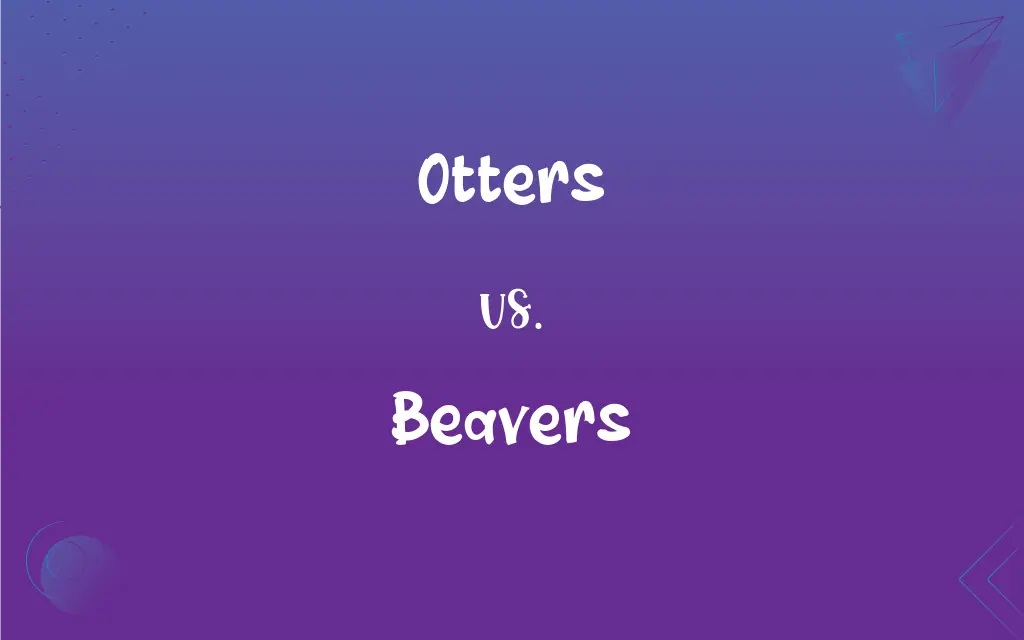Otters vs. Beavers: What's the Difference?
Edited by Aimie Carlson || By Harlon Moss || Published on March 3, 2024
Otters are semi-aquatic mammals known for their playful nature and agility in water, whereas Beavers are larger, primarily nocturnal, aquatic mammals, famous for building dams and lodges.

Key Differences
Otters are slender, agile mammals adapted for swimming, with webbed feet, dense fur, and a long tail. They are found in a variety of aquatic habitats worldwide. Beavers, on the other hand, are robust, primarily nocturnal rodents known for their dam-building skills. They have broad, flat tails, large incisors, and are found in North America and Eurasia.
In terms of behavior, Otters are known for their playful activities, such as sliding down riverbanks, and they often live in social groups. Beavers are more solitary but work together in family units to construct dams and lodges, which play a crucial role in altering ecosystems.
The diet of Otters varies greatly, but primarily they feed on fish, crustaceans, and small aquatic animals. They are adept hunters, using their agility and dexterity. Beavers are herbivores, feeding mainly on tree bark, leaves, and aquatic plants. Their sharp teeth allow them to effectively gnaw on wood.
Otters have a significant role in their ecosystem as predators, helping to control the populations of their prey. Their presence indicates a healthy aquatic system. Beavers, through their dam-building, create wetlands, which serve as habitats for a diverse range of species and help in water purification.
Otters have a variety of species, with some like the sea otter having a significant role in marine ecosystems, particularly in kelp forest environments. Beavers consist of two main species, the North American beaver and the Eurasian beaver, both vital for maintaining wetland ecosystems.
ADVERTISEMENT
Comparison Chart
Habitat
Aquatic environments worldwide
North America and Eurasia in freshwater bodies
Physical Traits
Slender, long-tailed, webbed feet
Robust, broad flat tail, large incisors
Behavior
Playful, social, agile swimmers
Nocturnal, solitary, skilled dam builders
Diet
Predominantly fish and small aquatic animals
Herbivorous, mainly tree bark and aquatic plants
Ecological Role
Predators, indicate healthy aquatic systems
Ecosystem engineers, create wetlands
ADVERTISEMENT
Otters and Beavers Definitions
Otters
Aquatic mammals known for their playful nature and sleek, agile bodies.
Otters are often seen sliding playfully down riverbanks.
Beavers
Large, nocturnal rodents known for building dams and lodges.
The beaver tirelessly worked at night to build its dam.
Otters
Carnivorous animals that primarily feed on fish and crustaceans.
In the wild, otters skillfully hunt for fish in the river.
Beavers
Keystone species in their ecosystems, creating wetlands.
The beaver's dam created a wetland that supported a diverse range of wildlife.
Otters
Social animals often found in groups, playing and hunting together.
A group of otters floated together, intertwined while resting.
Beavers
Mammals with large incisors and a flat tail, adapted for aquatic life.
The beaver used its flat tail to skillfully navigate through the water.
Otters
Important ecological indicators of a healthy aquatic ecosystem.
The presence of otters indicates a thriving and balanced river system.
Beavers
Herbivorous animals that primarily feed on wood, leaves, and bark.
Beavers gnaw on tree bark, which is a crucial part of their diet.
Otters
Mammals with dense, waterproof fur and webbed feet for swimming.
Otters use their webbed feet to maneuver gracefully underwater.
Beavers
Animals that significantly alter their environment, benefiting other species.
Beavers transform landscapes, making them habitable for various species.
Otters
Any of various aquatic or semiaquatic carnivorous mammals of the mustelid subfamily Lutrinae, having webbed feet and dense, dark brown fur.
Beavers
Either of two large semiaquatic rodents, Castor canadensis of North America or C. fiber of Eurasia, having thick brown fur, webbed hind feet, a broad flat tail, and sharp incisors used for gnawing bark and felling trees, with which they construct dams and underwater lodges.
Otters
The fur of one of these animals.
Otters
Plural of otter
FAQs
What do Otters eat?
Mainly fish, crustaceans, and small aquatic creatures.
What are Otters?
Semi-aquatic mammals known for their playful behavior and agility in water.
Where do Otters live?
In various aquatic habitats worldwide, both in fresh and marine waters.
What are Beavers?
Large, nocturnal rodents famous for their skill in building dams and lodges.
Where do Beavers live?
In freshwater bodies in North America and Eurasia.
What do Beavers eat?
They are herbivores, eating tree bark, leaves, and aquatic plants.
Are Otters social animals?
Yes, they often live in groups and show playful social behavior.
What is the ecological role of Otters?
They are predators and indicate healthy aquatic ecosystems.
What is the ecological role of Beavers?
Beavers are ecosystem engineers, creating wetlands beneficial for biodiversity.
How do Beavers build dams?
By gnawing on trees and using the wood, mud, and stones.
What kind of structures do Beavers build?
Dams to create ponds and lodges for living.
How do Otters hunt?
Using their agility and dexterity in water to catch prey.
How do Beavers interact with humans?
Often considered a nuisance for their dam-building but also admired for their engineering skills.
How do Otters and Beavers affect their environment?
Otters help control prey populations; Beavers alter landscapes creating wetlands.
What are the main threats to Beavers?
Habitat destruction and historically, trapping for fur.
Are Beavers solitary?
They are more solitary but work in family units for building structures.
What are the main threats to Otters?
Habitat loss, pollution, and hunting in some areas.
Can Otters live in the ocean?
Yes, some species like the sea otter are marine animals.
Do Otters build structures?
They don't build structures like beavers but may use dens or burrows.
How do Otters interact with humans?
Generally elusive but can be a tourist attraction in some areas.
About Author
Written by
Harlon MossHarlon is a seasoned quality moderator and accomplished content writer for Difference Wiki. An alumnus of the prestigious University of California, he earned his degree in Computer Science. Leveraging his academic background, Harlon brings a meticulous and informed perspective to his work, ensuring content accuracy and excellence.
Edited by
Aimie CarlsonAimie Carlson, holding a master's degree in English literature, is a fervent English language enthusiast. She lends her writing talents to Difference Wiki, a prominent website that specializes in comparisons, offering readers insightful analyses that both captivate and inform.







































































